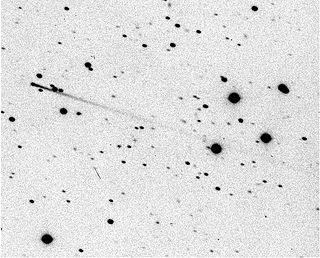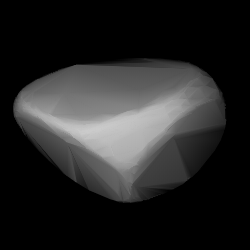
944 Hidalgo is a centaur and unusual object on an eccentric, cometary-like orbit between the asteroid belt and the outer Solar System, approximately 52 kilometers in diameter. Discovered by German astronomer Walter Baade in 1920, it is the first member of the dynamical class of centaurs ever to be discovered. The dark D-type object has a rotation period of 10.1 hours and likely an elongated shape. It was named after Mexican revolutionary Miguel Hidalgo y Costilla.

4015 Wilson–Harrington is an active asteroid known both as comet 107P/Wilson–Harrington and as asteroid 4015 Wilson–Harrington. It passed 0.4 AU (60 million km) from Earth on 20 July 2022 and then passed perihelion on 24 August 2022. It seldom gets brighter than apparent magnitude 16. It will return to perihelion on 25 November 2026.

Comet Elst–Pizarro is a body that displays characteristics of both asteroids and comets, and is the prototype of active asteroids. Its orbit keeps it within the asteroid belt, yet it displayed a dust tail like a comet while near perihelion in 1996, 2001, and 2007.
20461 Dioretsa is a centaur and damocloid on a retrograde, cometary-like orbit from the outer Solar System. It was discovered on 8 June 1999, by members of the LINEAR team at the Lincoln Laboratory Experimental Test Site near Socorro, New Mexico, United States. The highly eccentric unusual object measures approximately 14 kilometers in diameter. It was named Dioretsa, the word "asteroid" spelled backwards.
60558 Echeclus is a centaur, approximately 84 kilometers (52 miles) in diameter, located in the outer Solar System. It was discovered by Spacewatch in 2000 and initially classified as a minor planet with provisional designation 2000 EC98 (also written 2000 EC98). Research in 2001 by Rousselot and Petit at the Besançon observatory in France indicated that it was not a comet, but in December 2005 a cometary coma was detected. In early 2006 the Committee on Small Bodies Nomenclature (CSBN) gave it the cometary designation 174P/Echeclus. It last came to perihelion in April 2015, and was expected to reach about apparent magnitude 16.7 near opposition in September 2015.
118401 LINEAR, provisional designation 1999 RE70, is an asteroid and main-belt comet (176P/LINEAR) that was discovered by the Lincoln Near-Earth Asteroid Research (LINEAR) 1-metre telescopes in Socorro, New Mexico on September 7, 1999. (118401) LINEAR was discovered to be cometary on November 26, 2005, by Henry H. Hsieh and David C. Jewitt as part of the Hawaii Trails project using the Gemini North 8-m telescope on Mauna Kea and was confirmed by the University of Hawaii's 2.2-m (88-in) telescope on December 24–27, 2005, and Gemini on December 29, 2005. Observations using the Spitzer Space Telescope have resulted in an estimate of 4.0±0.4 km for the diameter of (118401) LINEAR.
14827 Hypnos is a highly eccentric, sub-kilometer-sized carbonaceous asteroid that is thought to be an extinct comet. It is classified as near-Earth object and potentially hazardous asteroid of the Apollo group.
1268 Libya, provisional designation 1930 HJ, is a dark Hildian asteroid from the outer regions of the asteroid belt, approximately 95 kilometers in diameter. It was discovered on 29 April 1930, by South African astronomer Cyril Jackson at the Union Observatory in Johannesburg, South Africa. The asteroid was named for the country Libya.
3192 A'Hearn, provisional designation 1982 BY1, is a carbonaceous asteroid from the inner regions of the asteroid belt, about 6 kilometers in diameter. It was discovered by American astronomer Edward Bowell at Lowell's Anderson Mesa Station in Flagstaff, Arizona, on 30 January 1982.
3290 Azabu, provisional designation 1973 SZ1, is a dynamical Hildian asteroid from the outermost regions of the asteroid belt, approximately 10–20 kilometers (6–10 miles) in diameter. It was discovered on 19 September 1973, by Dutch astronomers Ingrid and Cornelis van Houten at Leiden, and Tom Gehrels the Palomar Observatory. The asteroid has a rotation period of 7.67 hours. It was named after the former city district of Tokyo, Azabu.
3254 Bus, provisional designation 1982 UM, is a rare-type Hildian asteroid from the outermost region of the asteroid belt, approximately 32 kilometers in diameter. It was discovered on 17 October 1982, by American astronomer Edward Bowell at Lowell's Anderson Mesa Station in Flagstaff, Arizona. It is named after astronomer Schelte J. Bus.
4446 Carolyn, provisional designation 1985 TT, is a dark Hildian asteroid from the outermost regions of the asteroid belt, approximately 30 kilometers in diameter. It was discovered on 15 October 1985, by American astronomer Edward Bowell at the Anderson Mesa Station of the Lowell Observatory near Flagstaff, Arizona, in the United States. The asteroid was named after American astronomer Carolyn Shoemaker. It has a longer than average rotation period of 40.9 hours.

2483 Guinevere is a dark and elongated Hilda asteroid from the outermost regions of the asteroid belt, approximately 43 kilometers in diameter. The asteroid was discovered on 17 August 1928, by German astronomer Max Wolf at Heidelberg Observatory in southwest Germany and given the provisional designation 1928 QB. In the 1980s, it was named after King Arthur's wife Guinevere.
11573 Helmholtz, provisional designation 1993 SK3, is a Zhongguo asteroid from the outermost region of the asteroid belt, approximately 13 kilometers (8 miles) in diameter. It was discovered on 20 September 1993, by German astronomers Freimut Börngen and Lutz Schmadel at the Karl Schwarzschild Observatory in Tautenburg, Germany. It is one of few asteroids located in the 2:1 resonance with Jupiter. The asteroid was named for German physicist Hermann von Helmholtz.
11714 Mikebrown, provisional designation 1998 HQ51, is a stony background asteroid from the central region of the asteroid belt, approximately 4.5 kilometers (2.8 miles) in diameter. It was discovered on 28 April 1998, by astronomers of the Lowell Observatory Near-Earth Object Search (LONEOS) at the U.S. Anderson Mesa Station near Flagstaff, Arizona, and later named after American astronomer Michael Brown.
3688 Navajo, provisional designation 1981 FD, is a Griqua asteroid and a 2:1 Jupiter librator on an eccentric, cometary-like orbit from the outermost regions of the asteroid belt, approximately 6 kilometers in diameter. It was discovered on 30 March 1981, by American astronomer Edward Bowell at the Anderson Mesa Station near Flagstaff, Arizona. The dark P-type asteroid was named for the Native American Navajo people.
1529 Oterma, provisional designation 1938 BC, is a reddish, rare-type Hildian asteroid from the outermost region of the asteroid belt, approximately 56 kilometers in diameter. It was discovered on 26 January 1938, by Finnish astronomer Yrjö Väisälä at Turku Observatory in Southwest Finland. It is named for Liisi Oterma.
A quasi-Hilda comet (QHC) is a Jupiter-family comet that interacts strongly with Jupiter and undergoes extended temporary capture by it. These comets are associated with the Hilda asteroid zone in the 3:2 inner mean-motion resonance with Jupiter. Typically, asteroids in this zone have a semimajor axis between 3.70 and 4.20 AU, eccentricities below 0.30, and inclinations of no more than 20°. Comets can be temporarily perturbed into this group and then perturbed back out again. Eight percent of the comets that leave the 3:2 resonance end up impacting Jupiter.
(457175) 2008 GO98, provisional designation 2008 GO98 with cometary number 362P, is a Jupiter family comet in a quasi-Hilda orbit within the outermost regions of the asteroid belt. It was discovered on 8 April 2008, by astronomers of the Spacewatch program at Kitt Peak National Observatory near Tucson, Arizona, in the United States. This presumably carbonaceous body has a diameter of approximately 15 kilometers (9 miles) and rotation period of 10.7 hours.
(523676) 2013 UL10 (prov. designation:2013 UL10) is a reddish centaur with cometary activity orbiting the Sun between Jupiter and Uranus. It was discovered on 18 August 2010, by a team of astronomers with the Pan-STARRS survey at the Haleakalā Observatory, Hawaii. It is the first centaur known to have both comet-like activity and red surface colors. It is also one of the smallest centaurs, with a nucleus of no more than 10 kilometers (6.2 miles) in diameter. As of 2021, it has not been named.




